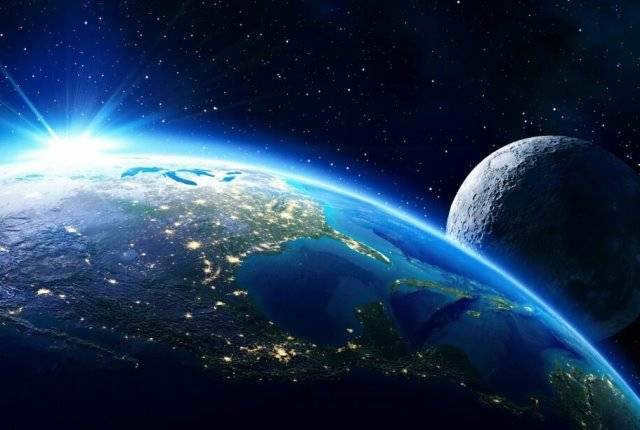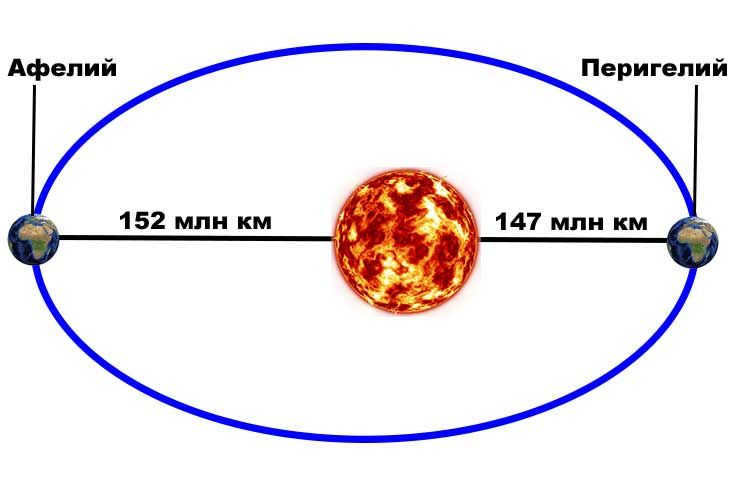
For quite some time, astronomers held the belief that the paths of celestial objects were circular. However, Johannes Kepler made the groundbreaking discovery that the planets, including our own Earth, actually follow an elliptical trajectory, with the Sun positioned at one of the foci of this ellipse.
An ellipse, which appears as a flattened circle, possesses a parameter known as eccentricity. This parameter determines how closely the shape of the ellipse resembles a circle. The eccentricity can range from zero to one. When the eccentricity is zero, the orbit becomes a perfect circle with the star located at its center. In the case of Earth, its eccentricity is 0.0167, indicating that our orbit is very nearly circular.
The point at which a star is farthest from its luminary is known as the apocenter, and the point closest to it is called the pericenter. The terms aphelion and perihelion are also used to describe the farthest and closest points in the orbits of the planets in our solar system. When the Earth is at aphelion, it is approximately 152 million kilometers away from the Sun, while at perihelion it is about 147 million kilometers.
This small variation in the Earth’s orbit radius is crucial for sustaining life on our planet, as it helps to maintain a stable average temperature. For comparison, the orbit radius of Mercury ranges between 46 and 70 million km, resulting in an eccentricity value of 0.2.
Magnetic Field Theory
The concept of magnetic fields is derived from the principles of physics. It is well-known that when two magnets with similar charged poles are brought close together, they repel each other. This fundamental principle forms the basis of the theory of magnetic fields. According to this theory, the Earth’s poles, which have the same charge, repel each other, resulting in different directions of magnetic forces. This phenomenon is what causes the Earth to rotate.
More recently, a new scientific hypothesis has emerged, suggesting that the Earth’s magnetosphere exerts a west-to-east force on its inner core. This force is believed to contribute to the faster rotation of the core around its axis compared to the rest of the Earth’s body.
The Earth’s axis tilt
The Earth’s axis is a straight line that passes through the geographic poles and the center of our planet. It is responsible for the Earth’s daily rotation.
Compared to the plane in which we orbit the Sun, this line is not perpendicular. Instead, it forms an angle of 66° 33′. This angle is the reason for the changing seasons, as it causes different parts of the Earth’s surface to receive varying amounts of heat and sunlight at different times.
After approximately 12,000 years, the telescope will be directed towards the star Vega, located on the opposite side of the sky. Then, after a similar span of time, it will be pointed back towards the alpha star of the Little Bear.
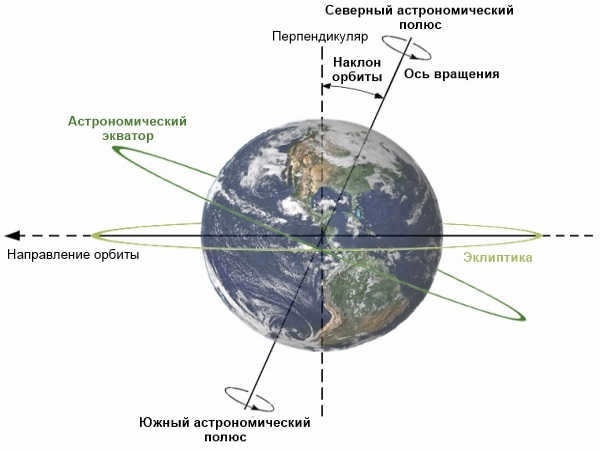
Graphical representation depicting the inclination of the earth.
Meridian
The earth rotates along an axis from west to east. Simultaneously, explorers led by Magellan traveled in the opposite direction, circling the planet from east to west, witnessing one less sunrise than Europe experienced during the journey. In order to avoid such confusing discrepancies every time someone chooses to circumnavigate the globe, a meridian has been established.
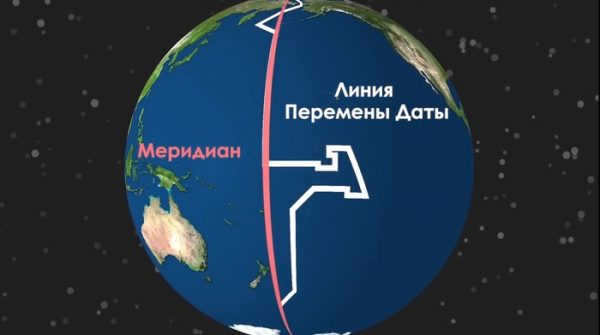
The International Date Line runs predominantly along the 180º meridian and serves as the demarcation where the time of day remains constant, while the calendar date changes.
For instance, if it is May 18th on the western side of the line, it is still May 17th on the eastern side. However, the clocks on both sides display roughly the same time.
In contrast to the prime meridian, the date line hardly ever touches land. As a result, there is usually no need to add or subtract a day as one travels around the globe. As mentioned, the majority of the line aligns with the 180º meridian, connecting the two poles and only intersecting land in Antarctica.
Regulation
In case of crossing the line, it is necessary to modify the date. When a vessel is moving from the east to the west, its crew should increment the calendar date by one. Conversely, if the vessel is traveling in the opposite direction, the crew should decrement the date. Furthermore, when the ship passes the meridian 180º while rounding the islands of Oceania, the crew has the privilege to modify the date, provided that the ship does not enter any port, and thus there is no need to synchronize with the local time.
Consequently, it becomes possible to experience the same day twice when crossing the line in a specific direction. Some individuals with romantic inclinations deliberately plan such a journey for special occasions like wedding anniversaries or birthdays.
The date line is essentially a conventional boundary that is not dictated by any physical law. It exists for the purpose of facilitating international communication. Crossing this boundary and changing from one date to another is akin to adjusting clocks during the transition to summer or winter time. These adjustments assist individuals in aligning their movements or activities with cosmic processes, but they are not directly derived from them.
Distance between the Sun and the Earth
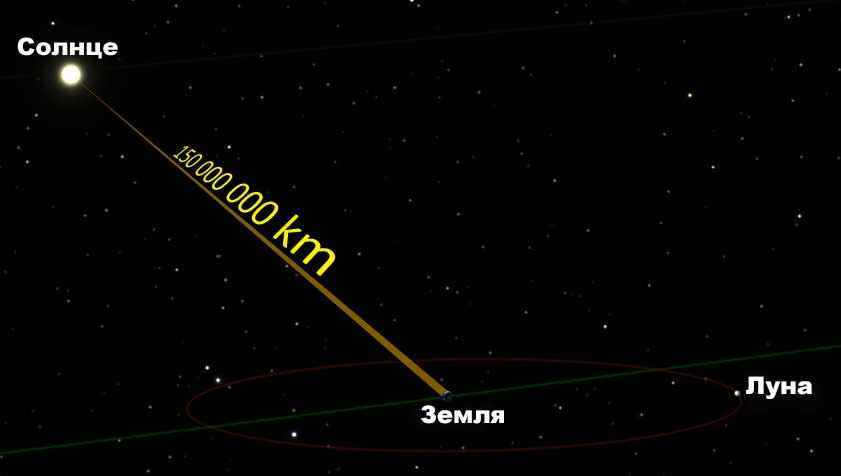
The astronomical unit, which is the average radius of the Earth’s orbit measuring 150 million kilometers, has been traditionally utilized to depict the solar system and serves as the unit of measurement for interstellar distances.
Soviet astronomers used the Venus radar method in 1961 to obtain a more precise measurement of the astronomical unit. They determined that it is approximately 149,599,300 ± 2000 km.
Rotation of the Earth
The Earth rotates on its axis from west to east. This movement is not noticeable because all objects move together and parallel to each other with the celestial body. When the Earth rotates, only two points remain stationary: the North Pole and the South Pole. If you connect these points with an imaginary line, you will get the axis around which the Earth rotates.
The Earth’s axis is tilted at an angle of 23.5 ° with respect to its orbit.
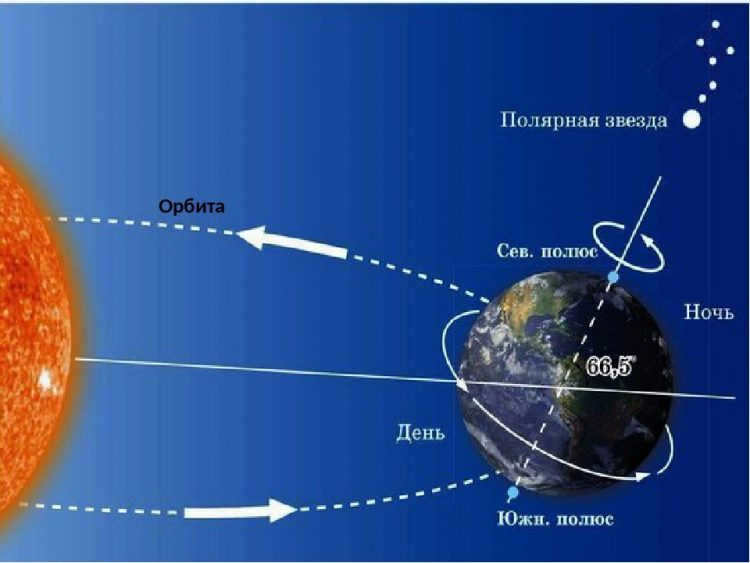
The Earth’s rotation around the Sun
One of the revolutions of the Earth is known as a daily revolution and lasts for 24 hours, specifically 23 hours 56 minutes, and a few seconds. The planet moves from west to east. This phenomenon accounts for the alternating periods of day and night: daylight is observed on the hemisphere that is facing the Sun, while the opposite side experiences darkness.
A day is divided into 24 hours (1440 minutes or 86400 seconds) and is conventionally categorized into four distinct intervals: morning, afternoon, evening, and night.
The planet’s rotation has the following characteristics and consequences:
- When observed from the North Pole, the planet rotates counterclockwise.
- The rate of rotation is 15 degrees per hour and is consistent worldwide on Earth.
- The planet’s rotational velocity is not constant. It is zero at the poles and increases as you approach the equator. The city of Quito is situated near the equator, which means that its residents unknowingly travel with the Earth at a speed of 465 m/s. However, Muscovites living far north of the equator will experience a rotation speed almost twice as fast: 260 m/s.
- At the equator, the rotational speed is approximately 1668 km/h.
The Earth’s Orbital Velocity
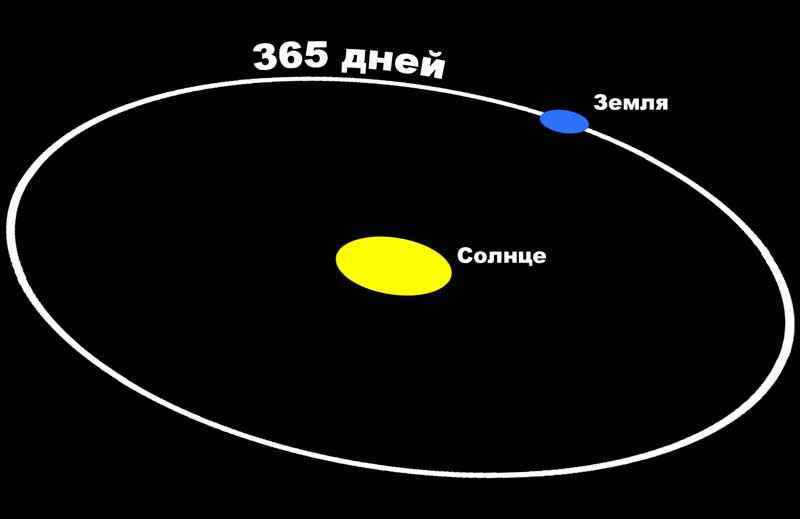
Our planet’s orbit has a total length of 940 million km, and it takes the Earth 365.25 days to complete this orbit. To account for this fractional day, a leap year is added every four years, with the addition of February 29. During this journey, celestial bodies move at varying speeds. At pericenters, planets move faster, while at apocenters, they slow down. On July 3, the Earth reaches aphelion and its speed slows down to 29.2 km/s. On January 3, our planet reaches perihelion and accelerates to 30.2 km/s.
Plane of Orbit
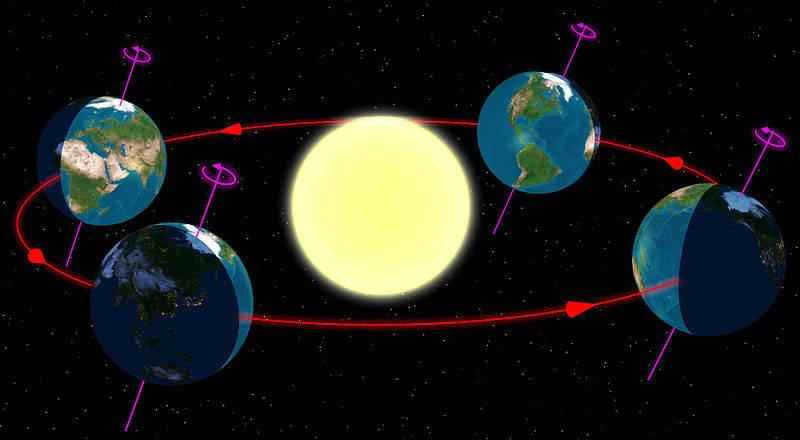
Every star’s orbit exists within a two-dimensional plane, meaning that all points of the orbit lie on the same flat surface. The Earth’s orbit, known as the ecliptic, is particularly fascinating because it aligns with the orbits of almost all known planets in our solar system. However, the Earth’s axis of rotation is tilted at a 23° angle in relation to the ecliptic. This tilt has significant consequences, such as the uneven heating of the northern and southern hemispheres during different parts of the orbit. These temperature variations give rise to the seasons, with summer occurring above the equator while winter takes place below it, and vice versa.
The sun also undergoes rotation on its axis, along with all the planets following suit in the same direction as the star. This serves as indirect proof that the material composing the planets and our star was once a solitary gas and dust cloud, from which the building blocks for the planets separated. However, there remains an anomaly that has yet to be explained. Specifically, the Sun itself deviates from the ecliptic by six degrees, a fact that lacks a clear explanation. Astronomers propose that this deviation could potentially be indicative of undiscovered planets within our solar system, which deviate from the ecliptic and, due to their gravitational influence, disrupt the Sun’s axis of rotation.
Deviation of the orbital from its ideal shape
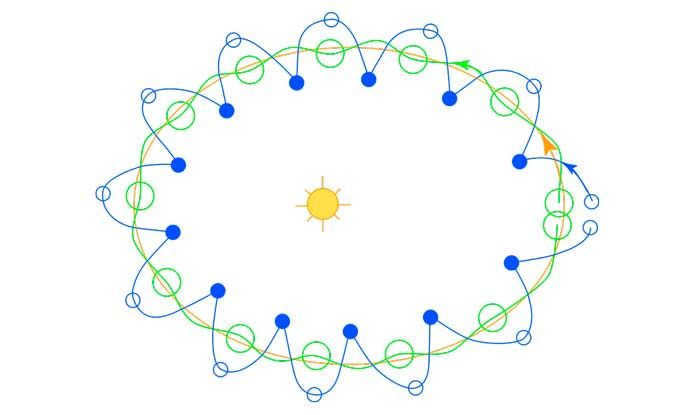
Kepler’s concept that the paths of celestial objects are elliptical accurately explained the behavior of the planets in the eyes of 17th-century observers, but as measurements became more precise, deviations from Kepler’s laws started to surface. The truth is that the mathematical model proposed by the German astronomer was founded on two simplifications:
- the mass of a planet can be considered negligible compared to the mass of a star;
- only the gravitational forces between the two bodies, the star and the planet, as well as the influence of other bodies (other planets), are taken into account.
Undoubtedly, the reality is much more intricate. In fact, it is more accurate to posit that the Sun and the Earth do not orbit each other, but instead both orbit a shared center of mass known as the center of gravity. However, due to the immense mass of the star, the center of gravity is situated within it.
Precise astronomical calculations reveal that in our present time, the distance between the Earth and the Sun is gradually expanding at a rate of 15 centimeters per year. Nevertheless, this does not imply that our planet will continually drift further away from the star, as periods of recession can alternate with periods of convergence.
As an illustration, astronomer Milutin Milankovitch made a discovery that the Earth’s orbit does not have a constant eccentricity, but instead undergoes cyclic changes. These cycles have a duration of approximately 100 thousand years, during which the eccentricity fluctuates between 0.005 and 0.05. It is precisely these variations that serve as the underlying cause of ice ages.
An additional day in the calendar
The Earth completes a full rotation on its axis in approximately 23 hours and 56 minutes, while it takes 365 days and 6 hours for the Earth to orbit the Sun. This slight difference in time gradually accumulates, resulting in an extra day being added to our calendar every 4 years (February 29), known as a leap year. Furthermore, this process is affected by the Moon, which is in close proximity to Earth and exerts a gravitational force that gradually slows down the Earth’s rotation, leading to a lengthening of the day by approximately one thousandth every 100 years.
There is a belief among certain scientists that the Earth used to rotate during its emergence and formation, but currently it continues to rotate due to inertia. As it formed from cosmic dust, it started attracting other celestial bodies and gained additional momentum. This hypothesis is also applicable to the other planets in our solar system.
However, there are many critics of this theory, as it fails to explain the variations in the Earth’s rotational speed at different times. Additionally, it remains unclear why certain planets in the solar system, like Venus, rotate in the opposite direction.
Does the Earth’s orbit remain stable?
According to Kepler’s laws, planets have the ability to orbit a star indefinitely. However, deviations from these laws can lead to variations and instability, potentially causing planets to either stray from their orbits or collide with the star. Since it is not possible to analytically calculate these deviations, computer modeling is necessary.
The calculations made through computer modeling do not provide a definitive prediction for the fate of the planets in our solar system. In certain models, Mercury falls into the Sun or collides with Venus or Earth, potentially leading to further planetary collisions. However, these events are projected to occur billions of years in the future.
True and mean solar time
Local solar time is determined by the position of the sun. Due to the elliptical orbit of the Earth around the Sun and the Earth’s axial tilt, true solar time is not constant. Throughout the year, the length of true solar days can vary by up to 50 minutes, with the beginning of the day deviating from its average by as much as 16 minutes.
To determine the precise local solar time, one can measure the hour angle of the Sun using a specialized astronomical instrument. Alternatively, an approximate solar time can be determined using a sundial, although this method may be less accurate due to the blurring of shadows.
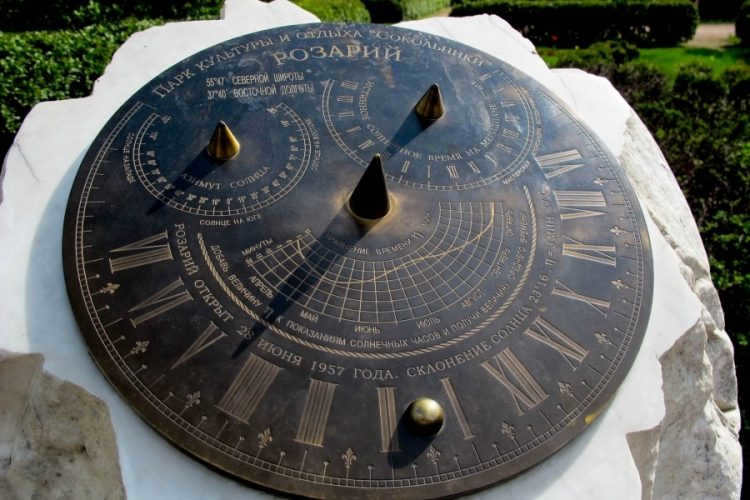
Prior to the 18th century, the common man relied on local real solar time. However, with the advent of mechanical clocks and their constant improvement, mean solar time gradually replaced real time in various states. This shift began in Geneva in 1780, followed by London in 1792, Berlin in 1810, and Paris in 1816.
Nowadays, local real solar time is primarily used by astronomers. Its significance diminished in the late 19th and early 20th centuries due to the implementation of time zones and the solar time system.
Major changes in the climate are on the horizon
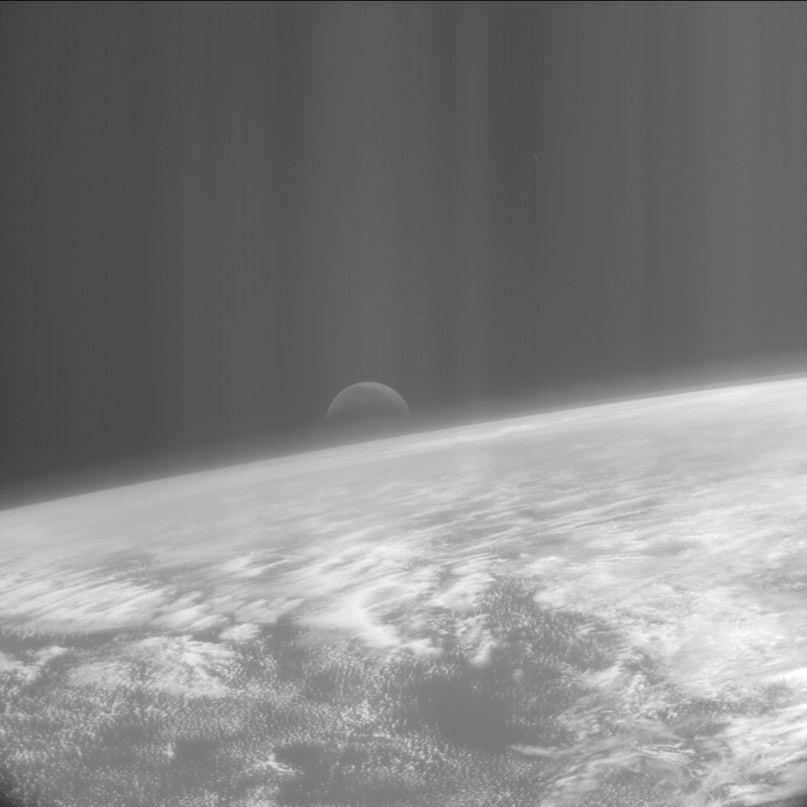
Moonrise above the Pacific Ocean.
The change of season occurs because of the tilt of the Earth’s axis in relation to the Sun’s orbit, which is currently at an angle of 66° 33. The influence of other satellites and planets does not alter the Earth’s axis tilt, but it does cause the Earth to move in a circular cone, a process known as precession. Presently, the Earth’s axis is positioned in a way that the North Pole is directly opposite Polaris. Over the next 12,000 years, the Earth’s axis will undergo a shift due to the effects of precession and align with the star Vega, which is only halfway there (a complete precession cycle takes 25,800 years). This will lead to a significant climate change throughout the entire duration of the Earth’s surface.
The Sun’s Influence Hypothesis
The prevailing theory suggests that the radiation emitted by the Sun is the primary factor influencing Earth’s conditions. The Sun’s heat affects the Earth’s surface layers, including the atmosphere, seas, and oceans. However, this heating process is not uniform, leading to the formation of sea currents and air movements.
These currents and movements interact with the solid shell of the planet, resulting in the rotation of the Earth. The continents act as vortices, determining the speed and direction of this motion. If the continents are not sufficiently solid, they may start to drift, which can impact the velocity of the Earth’s rotation.
This hypothesis describes a specific trajectory of the planet’s motion. As we know, the Earth orbits around the Sun, with the average distance between our planet and the main luminary currently established at 149.6 million kilometers.
The Earth’s Orbit: A Revolutionary Discovery
In ancient times, the prevailing belief was in the geocentric model of the universe, which posited that the Earth was the central point around which all celestial bodies revolved. However, this perspective was later replaced by the heliocentric model, which placed the Sun at the center and explained the motion of cosmic bodies around it. This new view also offered insights into the movement of planets within the solar system, revealing that their orbits were not circular as previously thought. Instead, scientists began to conceptualize planetary orbits as spherical shapes based on observational evidence.
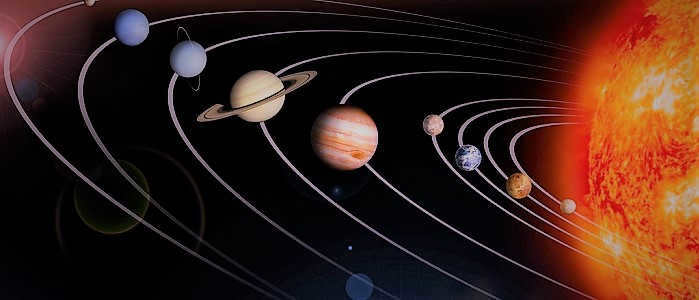
The configurations of the planets in the celestial system
It is important to mention that numerous brilliant scientists dedicated their efforts to studying the structure of the cosmos. Notable figures such as Ptolemy, Plato, and Aristotle contributed to this field. Furthermore, Nicolaus Copernicus played a pivotal role in advancing our understanding of the universe. He also made significant contributions to the development of the heliocentric theory, which kickstarted the exploration of the Earth’s orbit.

A depiction of Nicolaus Copernicus
What is the orbit of the Earth?
As we now understand, the Earth orbits the Sun along a specific path. What does this path look like?
Johannes Kepler concluded that the planets travel along an elliptical path. This includes our Earth. Prior to this discovery, astronomers believed that the path was a perfect circle.
Now, an elliptical orbit is similar to a flattened circle. It also has a measure of eccentricity, which determines how closely it resembles a circle. Eccentricity can range from 0 to 1, with 0 being a perfect circle with the Sun at the center, and 1 being a highly elongated shape.
The eccentricity of the Earth’s orbit is 0.0167. In other words, the Earth’s orbit closely resembles a slightly elongated circle.
Moreover, a crucial aspect in the assessment of an orbit is the distance between the celestial body and its primary luminary. To determine this, specific points are identified along the orbit:
- apocenter – the maximum distance between the body and its luminary;
- pericenter – the minimum distance to the central luminary.
Characteristics of Earth’s Orbital Path
On the flip side, the Earth’s orbital path is distinguished by two key points: aphelion, which is the farthest point from the Sun, and perihelion, which is the closest point to the Sun. When the Earth is at aphelion, it is approximately 152 million km away from the Sun, while at perihelion, it is around 147 million km away. However, the average distance is generally considered to be 149.6 million km.
In fact, even a slight alteration in the Earth’s circular orbit can have a significant impact on the planet’s life. This is because the orbital position directly influences the temperature conditions experienced on Earth.
As previously mentioned, the tilt of the planet’s axis greatly affects our orbit, resulting in the seasonal weather patterns that we experience. In simpler terms, this is what causes the changes in seasons. It is the Earth’s axis rotation that leads to the occurrence of solstices and equinoxes.
The plane of orbit
It is fascinating to note that all celestial bodies have orbits that can be described as flat shapes. This is because all the points of their movement lie on the same plane. Interestingly, the Earth’s orbital plane is known as the ecliptic. Furthermore, the orbits of all the planets in the solar system are similarly aligned.
The Earth’s axis of rotation is inclined at an angle of 23 degrees with respect to the ecliptic. This inclination is the reason why different hemispheres of the Earth experience varying levels of heating, resulting in distinct weather conditions during the different seasons.
Living on Earth may come with a high price tag, but one perk is getting a complimentary annual cruise around the Sun.
The ongoing study and exploration of our planet, Earth, is driven by its constant motion. However, this motion is not uniform.
Interestingly, Kepler’s laws suggest that celestial bodies can orbit the main star for their entire existence. However, there can be variations in their trajectory. As a result, scientists have proposed various scenarios for when and how planets might deviate from their regular orbits.
To make predictions, computer modeling is currently employed. The outcome reveals multiple potential futures for our solar system. Ultimately, only time will reveal what will actually transpire.
How does the Earth travel through the vastness of space? Now we have a full understanding
If you were to ask a scientist about our place in the cosmos, they would provide you with a comprehensive response. We reside on planet Earth, which spins on its axis and orbits around the Sun. The Sun, in turn, follows an elliptical path around the center of the Milky Way galaxy, which extends towards Andromeda within our Local Group. The Local Group itself moves within the expansive Laniakea Supercluster, comprised of galactic groups, clusters, and cosmic voids. All of these entities exist within the KBC region, situated in the heart of the Universe’s grand structure. After years of scientific investigation, we now possess a complete understanding of this celestial motion and can accurately determine our speed at any scale within the cosmos.
Within the solar system, the rotation of the Earth plays a vital role in the formation of equatorial thickening, the alternation of day and night, and the generation of the magnetic field that shields us from cosmic rays and solar wind.
It is likely that while reading this, you perceive yourself to be stationary. However, we are aware that on a cosmic scale, we are in motion. To begin with, the Earth is rotating on its axis and propelling us through space at a velocity of approximately 1700 km/h relative to someone located on the equator. This may appear to be a considerable speed, but in comparison to other velocities in the universe, it is hardly noticeable. In fact, when measured in kilometers per second, it is not particularly fast. As the Earth rotates on its axis, it imparts a velocity of only 0.5 kilometers per second, which is less than 0.001% of the speed of light. However, there are other movements that are more significant.
The velocity at which the planets orbit the Sun surpasses the velocity at which they rotate around their own axis, even in the case of the swiftest planets, Jupiter and Saturn.
Similar to all the planets within our solar system, the Earth revolves around the Sun at a much higher speed than its rotation around its own axis. In order to remain in a stable orbit, we must move to the right at a velocity of approximately 30 km/s. The inner planets, Mercury and Venus, have faster movement, while the outer planets (such as Mars and the ones beyond it) have slower movement. As the planets rotate within the plane of the solar system, their direction of motion continuously changes, and the Earth completes a full revolution in 365 days. Well, almost back to its starting point.
A precise model portraying the movement of the planets as they orbit the Sun, which itself orbits the Galaxy in a different direction.
Even the Sun itself is constantly in motion. The Milky Way is vast, immense, and most importantly, it is in motion. All the celestial bodies, such as stars, planets, gas clouds, dust particles, black holes, and dark matter, are all moving within the Milky Way, contributing to its gravitational field. From our perspective, as we are located approximately 25,000 light years away from the Galactic center, the Sun follows an elliptical path and completes a full revolution every 220-250 million years.
It is estimated that our Sun travels at a speed of 200-220 km/s along this trajectory, which is significantly faster than both the Earth’s rotation and our planet’s orbit around the Sun. Moreover, both of these rotations are inclined relative to the plane of our star’s motion around the Galaxy.

Despite the fact that the Sun’s orbits in the Milky Way are approximately 25000-27000 light years away from the center, the planetary orbits in our solar system are not aligned with the Galaxy.
However, the Galaxy itself is not stationary. It is in motion due to the gravitational attraction from dense regions of matter and the lack of gravitational pull from less dense regions. Within our Local Group, we can calculate our velocity towards the largest and most massive galaxy nearby, Andromeda. It appears to be moving towards our Sun at a speed of 301 km/s, which means that the two most massive galaxies in the Local Group, Andromeda and the Milky Way, are moving towards each other at approximately 109 km/s.
Andromeda, the biggest galaxy in the Local Group, may seem diminutive and unimportant in comparison to the Milky Way, but this is solely due to its immense distance of approximately 2.5 million light-years. At present, it is journeying towards our Sun at an astonishing velocity of roughly 300 kilometers per second.
The local cluster, despite its enormous size, is not completely isolated. Nearby galaxies and galaxy clusters are attracted to us, and even more distant masses of matter have a gravitational impact on Earth. From our observations, measurements, and calculations, it seems that these structures contribute to an extra velocity of approximately 300 km/s, albeit in a slightly different direction from the other combined velocities. This accounts for some of the movement in the Universe at a macroscopic level, but not all of it. Furthermore, there is another significant phenomenon that has recently been quantified – the gravitational repulsion of cosmic voids.
The galaxies within the Virgo Superscale have formed clusters and groups. On a larger scale, the Universe is uniform, but when observing galaxies or clusters, it becomes evident that there are regions of high density and regions of below-average density.
Each atom or particle of matter that accumulates in a highly dense region is balanced by a region that has lost an equivalent amount of mass and now has an average density. Similar to how denser areas attract, regions with lower density will attract with a force that is below average.
The Milky Way experiences gravitational attraction (shown in blue) from superdense regions and relative repulsion (shown in red) from regions of lower-than-average density.
When we combine all of these motions together – the Earth’s rotation on its axis, its rotation around the Sun, the Sun’s motion through the Galaxy towards the Andromeda Nebula, and the motion of the Local Group attracted to areas of superdensity and repelled from areas of below-average density – we can determine our actual speed in the Universe at any given time.
It has been discovered that the Earth is actually moving at a speed of 360 km/s in a specific direction, with a slight variation of about 30 km/h depending on the time of year and direction. The accuracy of these findings regarding the Earth’s speed has been supported by relic radiation, which is more pronounced in the direction of the planet’s motion and less pronounced in the opposite direction.
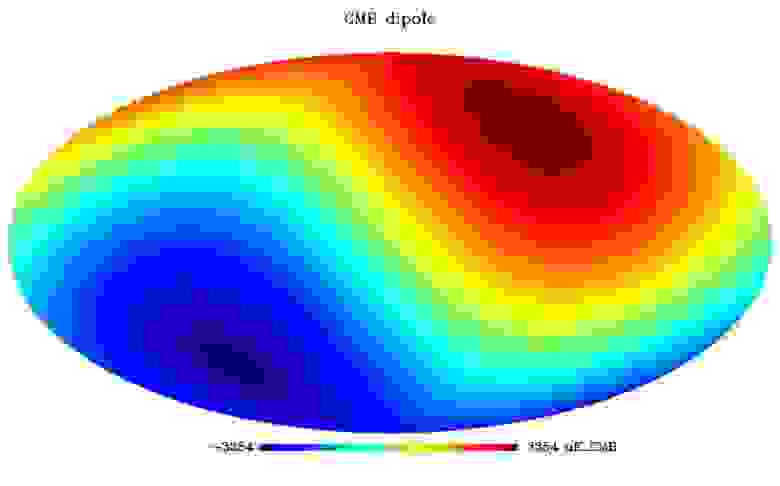
The residual glow from the Big Bang has a temperature that is 3.36 millikelvin higher than the average temperature in one direction (red) and 3.36 millikelvin lower than the average temperature in the other direction (blue). This temperature difference is a result of the overall motion in space.
If we disregard the Earth’s motion, we can determine that the Sun is moving relative to the relic radiation at a speed of 368 ± 2 kilometers. Similarly, if we ignore the motion of the Local Group, it can be concluded that the Milky Way, Andromeda, the Triangle Galaxy, and all other galaxies are moving relative to the relic radiation at a speed of 622 ± 22 kilometers. The large uncertainty in this measurement is primarily due to the uncertainty in measuring the motion of the Sun around the center of the Galaxy, which is the most challenging component to measure accurately.
The Dipole Repulsion is a phenomenon that arises from the interplay between the over-dense and under-dense regions of the Milky Way, resulting in both attractive and repulsive effects.
When it comes to understanding the enigmas of the universe, human beings cannot do without assistants, and artificial intelligence can serve as an excellent companion in this regard. If AI was initially developed to make our lives easier on Earth, why not utilize it for space exploration as well? Numerous organizations, such as NASA and Google, have already incorporated AI into their efforts to discover new celestial bodies and extraterrestrial life, and they are always eager to collaborate with experts in AI and neural networks. Our Machine Learning, Machine Learning, and Deep Learning courses will equip you with the skills necessary to work in these exciting fields.
However, there is still plenty of important work to be done right here on Earth. You can learn how to excel in other fascinating engineering disciplines or start from scratch and acquire these skills:
Earth, the third planet from the sun, ranks fifth in terms of size among the planets in our solar system:
Orbit: The Earth orbits at a distance of 149,600,000.0 km (1.00 AU) with a diameter of 12,756.3 km and a mass of 5.9736e24 kg.
The Earth is unique among the planets in that its name does not come from Greek or Roman mythology. Instead, it derives its name from ancient English or German languages. Of course, there are various names for this planet in other languages. In Roman mythology, the Earth goddess was known as Tellusa (Tellus), while in Greek mythology, she was called Gaia. Another name for Earth is “terra mater,” which means Mother Earth.
It wasn’t until the sixteenth century, during the time of Copernicus, that it was confirmed that Earth is just one of the planets in our solar system.
Exploration of Earth has traditionally been conducted without the aid of spacecraft. However, it wasn’t until the 20th century that scientists were able to fully comprehend the planet due to the lack of a complete map. The stunning and significant images captured from space have revolutionized our understanding of Earth. These images assist in various ways, such as aiding in weather forecasting and tracking and predicting hurricanes.
Earth is composed of multiple layers, each with their own unique chemical and seismic properties. The depths of these layers are as follows (in km):
0-40 Earth crust
40-400 Upper mantle
400-650 Transition zone
650-2700 Lower mantle
2700-2890 D”-layer
2890-5150 Outer core
5150-6378 Inner core
The thickness of the Earth’s crust is not distributed evenly; it varies in size across different regions. For instance, it is thinnest in the oceans but significantly thicker under the continents. The Earth’s inner core and crust are solid, while the outer core and mantle have a more fluid-like consistency. These layers are separated by boundaries, which can be observed on seismograms. One well-known boundary is the Mohorovicic boundary, which marks the transition between the Earth’s crust and the upper mantle.
The mantle makes up the largest portion of the Earth’s mass, followed by the core. In comparison, the portion of the Earth that can support life is minuscule in size.
The weight of the atmosphere is 0.0000051 x 1024 kg, the weight of the oceans is 0.0014 x 1024 kg, the weight of Earth’s crust is 0.026 x 1024 kg, the weight of the mantle is 4.043 x 1024 kg, the weight of the outer core is 1.835 x 1024 kg, and the weight of the inner core is 0.09675 x 1024 kg.
It is possible that the core is predominantly made up of iron (or nickel), but there is also a chance that lighter elements may be present. The temperature at the center of the core can reach over 7500 K, which is hotter than the surface of the Sun! The lower layer of the mantle is primarily composed of silicon, magnesium, oxygen, iron, calcium, and aluminum. The chemical makeup of the upper layer of the mantle consists mainly of olivine, pyroxene (iron/magnesium silicates), calcium, and aluminum. Seismic studies have provided most of the information about these layers, as only a few samples of upper mantle material have reached the Earth’s surface during volcanic eruptions. The majority of the Earth’s interior remains inaccessible. The crust is mainly composed of quartz (silica) and other silicates like feldspar. The overall chemical composition of the Earth (by mass) is as follows:
Earth is the most compact of the large celestial bodies in the Solar System.
The other members of the Earth group likely possess similar structure and composition, albeit with some variations: the Moon possesses the smallest nucleus; Mercury boasts a nucleus that is disproportionately large compared to its diameter; the mantles of Mars and the Moon are considerably thicker than that of Earth; Mercury and the Moon likely lack a chemically distinct crust and it appears that only Earth possesses a discernible inner core. It is worth noting, however, that our understanding of the internal makeup of the planets is even more speculative than our understanding of Earth’s composition.
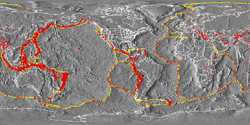
In addition to these, there are also approximately twenty smaller plates including the Arabian, Cocos, and Philippine plates. Earthquakes are common at their boundaries. The plate boundaries can be clearly seen on the map to the right, with the locations of earthquakes (represented by red dots). The Earth’s surface is relatively young. Over a period of about 500 million years, erosion and tectonic processes have significantly changed and transformed the Earth’s surface, erasing most evidence of its previous geological history (such as meteor crater tracks). The earlier history of the Earth has been largely wiped away. The Earth is estimated to be around 4.5-4.6 billion years old, but the oldest known rocks are only 4 billion years old, and rocks older than 3 billion years are extremely rare. The oldest fossils discovered are from organisms that lived less than 3.9 billion years ago. We have no record of the origin of life on Earth. Approximately 71 percent of the Earth’s surface is covered by water. Earth is the only planet where water can exist in liquid form on the surface (although there may be liquid ethane or methane on Titan’s surface, and liquid water beneath Europa’s surface). Water is essential for the existence of known forms of life on Earth. The oceans also play a crucial role in regulating the Earth’s temperature. Water is involved in erosion processes and shaping the weather on the Earth’s continents. In the entire solar system, water erosion is only actively occurring on Earth (although it is possible that erosion of this kind occurred in the past on Mars). The Earth’s atmosphere is composed of 77% nitrogen, 21% oxygen, and small amounts of argon, carbon dioxide, and water vapor. There may have been a higher concentration of carbon dioxide in the Earth’s atmosphere during its formation, but most of it is now locked up in carbonate sedimentary rocks, dissolved in the oceans, or consumed by plants. Tectonic and biological processes maintain a cycle of carbon dioxide in the atmosphere. The small amount of carbon dioxide present in the atmosphere is crucial for maintaining a stable temperature on the Earth’s surface through the greenhouse effect. The greenhouse effect raises the average temperature by about 35 degrees Celsius, preventing the oceans from freezing and allowing life to exist in its current form. The presence of free oxygen in the atmosphere is chemically remarkable. Oxygen is a highly reactive gas and should have reacted with other elements long ago under “normal” conditions. The presence of oxygen in the Earth’s atmosphere is due to biological processes, and without life on Earth, there would be no oxygen. The Earth’s interaction with the Moon causes a gradual slowing of the Earth’s rotation by over two milliseconds per century. Recent research suggests that for around 900 million years, there were 481 days in a year, with each day lasting only 18 hours. The Earth has a moderate magnetic field generated by electric currents in its core. The interaction between the solar wind and the Earth’s magnetic field and upper atmosphere produces the phenomenon known as the aurora borealis. Variations in these factors can cause movement of the magnetic poles and even a reversal of the Earth’s magnetic field. Currently, the magnetic north pole is located in northern Canada. (The geomagnetic north pole is the point on the Earth’s surface directly above the south magnetic pole of the Earth’s magnetic field). The interaction between the Earth’s magnetic field and the solar wind also creates radiation belts, known as the Van Allen belts, which consist of two rings of ionized gas (plasma) trapped by the Earth’s magnetic field in orbit around the planet. The outer radiation belt is located between 19,000 km and 41,000 km above the Earth’s surface, while the inner radiation belt is found between 7,600 and 13,000 kilometers.
Earth satellite
- Orbiting the Earth are thousands of small satellites that have been created by humans.
- Asteroid 3753 (1986TO) has a rather complex relationship with the Earth’s orbit. It is not considered another “moon”, but rather a “companion”. A similar situation can be seen with Saturn’s satellites Janus and Epimetheus.
- The hypothetical Earth satellite Lilith is a fascinating story, although it does not actually exist.
Discover more information about Earth and the Moon
- Explore additional Earth images and photographs
- Access resources from ASU
- Find content from LANL
- Learn about the Internal Structure of the Earth with Rosanna L. Hamilton of LANL
- Discover data from JPL
- Access information from RPIF
- Learn about Earth from StarDate
- Find data from NSSDC
- Access resources from TPS
- Discover information from NASA Space Links
- Explore LANL’s photos of Earth Clouds from space
- Learn about Earth Craters with descriptions and images from LANL
- View images of Terrestrial and Hawaiian Volcanoes from LANL
- Discover information about Volcanoes of the World
- Explore Electric Volcanoes with Electric Volcano
- Learn about Volcanic Activity in Hawaii and Other Parts of the World from ExInEd Hypercard Compendiums
- Discover ways to observe the Earth with ExInEd Hypercard Compendiums
- Compare the Earth with its Neighboring Planets using ExInEd Hypercard Compendiums
- Virtual Geomorphology
- Earth’s Magnetosphere: A Comprehensive Guide
- Unraveling the Mysteries of the Magnetosphere
- Earth Explorer: Discover the Interactive Map of Zamli
- The Big Globe of Earth: Exploring Our Planet in 3D
- Astronauts’ Perspective: Earth’s Beauty from Space (featuring images and quotes from Calvin Hamilton of LANL)
- Earth from Space: Stunning Images Captured by NASA
- Geographic Resources: A Wealth of Information at Your Fingertips
- Why is the Sky Blue? Understanding the Science Behind it
- Discover the USA: Jaw-Dropping Landsat Images
- AVHRR Images: Unlocking a World of Remote Sensing Data
Unresolved Issues
- The majority of our understanding of the Earth’s internal structure is primarily acquired through indirect means. How can we obtain more direct information?
- Despite the gradual and steady increase in the solar “constant,” the Earth’s average temperature has remained remarkably stable for billions of years. This phenomenon can be best explained by the fluctuation in carbon dioxide levels in the atmosphere, which regulates the greenhouse effect. However, the exact workings of this mechanism are still unclear. The Gaia hypothesis suggests that the biosphere actively participates in this regulation. Further exploration of Venus and Mars could provide valuable insights into this question.
- What is the threshold for carbon dioxide emissions into the atmosphere before Earth undergoes a transformation similar to Venus?
Vanga’s predictions regarding the Earth’s orbit displacement
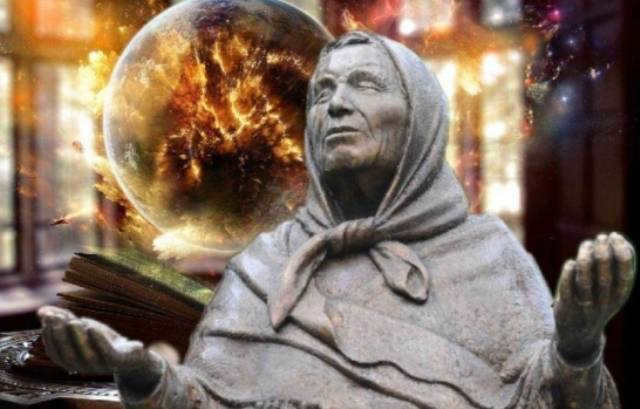
In 2023, there is a possibility that the Earth’s orbit may experience a shift, according to Bulgarian clairvoyant Vanga. Throughout her lifetime, she made numerous predictions, many of which were centered around various cataclysms occurring on our planet.
It is now known that some of the famous clairvoyant’s prophecies have actually come true. These include the terrorist attacks on the World Trade Center towers in New York, the tragic sinking of the Russian submarine “Kursk”, and the deaths of numerous celebrities.
However, there are also predictions that have not yet materialized, despite their expected dates having already passed. For instance, the onset of World War III in 2010 was averted by humanity’s efforts.
Regarding the Earth’s orbit displacement, which, as predicted by Vanga, we anticipate by 2023, it is important to note that As per the clairvoyant’s own words, it will not initiate a catastrophe for Earth, nor will 2023 be a year of significant upheavals for the people of our planet. Therefore, any concerns about this matter are baseless.
Scientists’ Opinions on the Potential Shifting of Earth’s Orbit
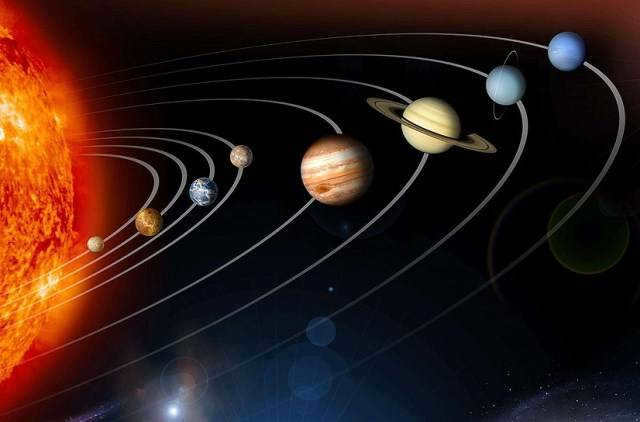
Scientists have long been studying the issue of changing the Earth’s orbit and it is not considered unexpected or unpredictable, as reported by the news outlet comandir.com. They are well aware that the processes causing changes in the planet’s orbit have been ongoing for a long time.
Due to the gravitational fields of Venus, the nearest planet, and Jupiter, the largest planet in our solar system, the Earth’s orbit is continuously being compressed and stretched. This results in a change of about 1% in the Earth’s orbit every 450 years.
This process has been occurring uninterruptedly for over 215 million years. During periods of intense compression or expansion of the Earth’s orbit, there are alterations in climate, shifts in the poles, and the extinction of certain animal species that are unable to adapt to the new environmental conditions.
The current state of the Earth’s orbit
